Ultimate Jump Rope Guide: All To Know Before Buying
Author:
Reviewed by:
(21 years of Oly Lifting experience)
Unlock your full potential by engaging with our experts and community! Have questions about your fitness journey or looking for expert advice on weightlifting techniques? Don’t hesitate — leave a comment below and Ihor Shymechko will provide a personalized answer and insights to help you reach your goals.
Torokhtiy is reader-supported. Some links are affiliate links, and we may earn a commission at no extra cost to you. See our disclosure page for details.
Do you remember being a kid and jumping rope with your friends? You never thought about its benefits, you only thought of how fun it is. But this isn’t just for kids — it’s a fantastic way to stay in shape, but you need to find one that’s good to get the benefits.
There’s not a lot of fun things from your childhood that can so easily translate into adulthood, but jumping rope is absolutely one of them.
You can be a professional, an experienced fitness enthusiast, or a couch potato looking for a way to be active – everyone can learn how to jump rope. It’s easy, has a ton of benefits, and doesn’t require expensive equipment.
Let’s jump right into this and see what you need to know before buying!
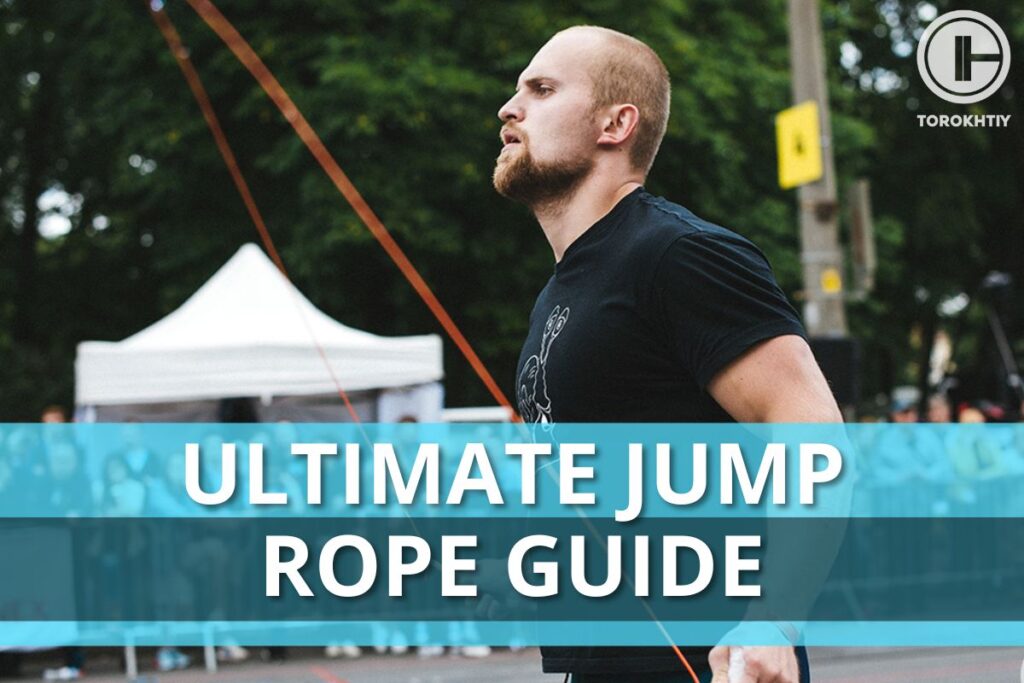
5 Main Types of Jump Ropes
“Jump rope” is far more than just a random rope with a handle on each end. Say you walk into a store and ask about fitness jump ropes – you won’t be given a rope straight from the shelf. Instead, the sales associate will start asking you what kind of rope you want and will probably list a few types for you to choose from.
This is where it gets tricky, because you may not be familiar with all the types, so it’s difficult to make a choice. Let’s make sure this scenario never happens and look through a few different types of jump ropes.
1. Standard Jump Ropes
These are your traditional and most common ropes. Standard ropes are usually made of PVC or nylon and have lightweight handles. If you’ve ever jumped rope as a kid, you used this type because it’s easy, versatile, and suitable for everyone.
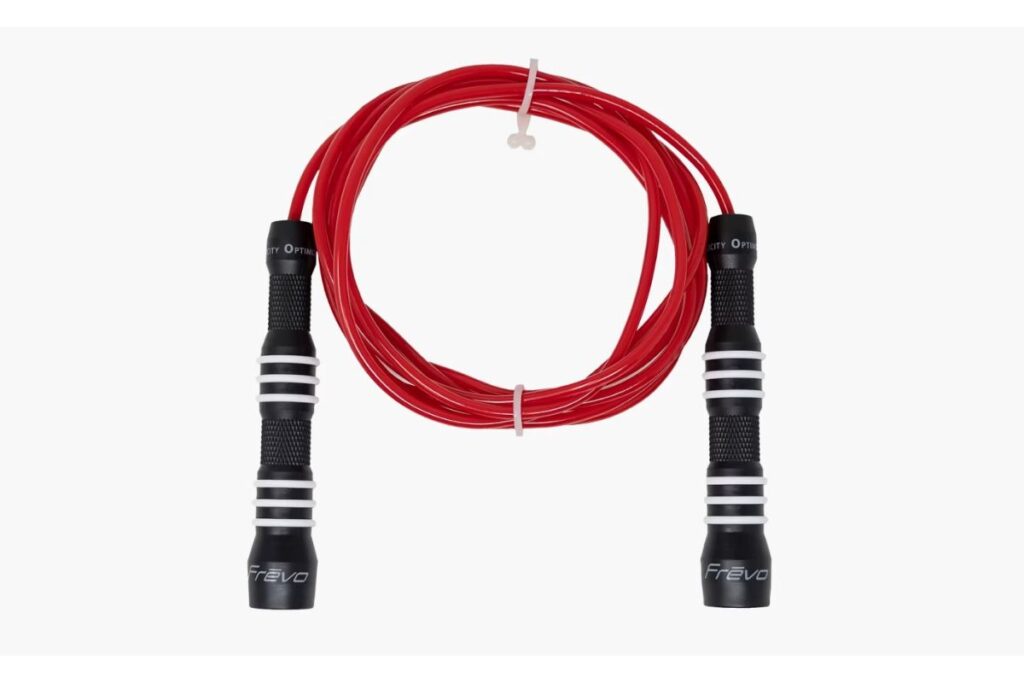
2. Speed Ropes
Like the name would suggest, these ropes are designed for speed and have different (some would even say better) handle mechanisms that allow for faster turns and minimize tangling.
You’ll easily recognize them because their cables are super thin (so they can move fast), and if you happen to hold one in your hands, you’ll feel how light the handles are. They’re good for athletes, boxers, and people who want to work on their speed, agility, and coordination.
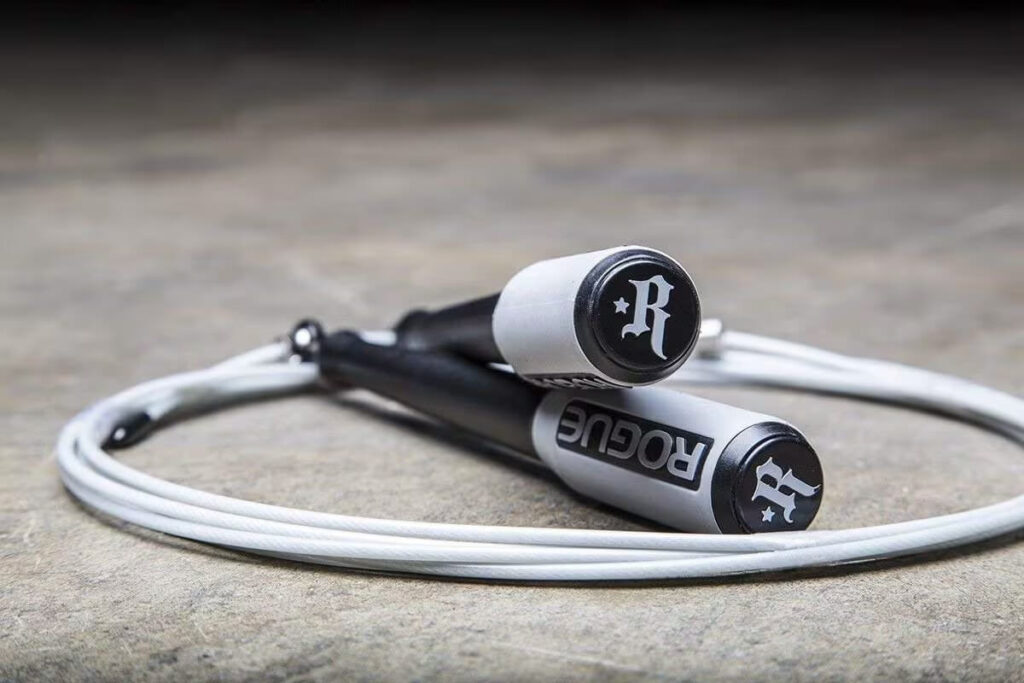
3. Weighted Jump Ropes
These have added weight, either to the handle or/and to the rope itself, which provides resistance during workouts to intensify them. They’re great for burning calories, building shoulder endurance, and improving your cardiovascular health. They’re suitable for people who are more advanced, so keep that in mind if you’re a beginner.
Our expert and Olympian Oleksiy Torokhtiy said:
“In Olympic weightlifting, there is no practice of using a jump rope in an athlete’s preparation, although some athletes may use one in the off-season. In team sports, this is more popular and in demand.“
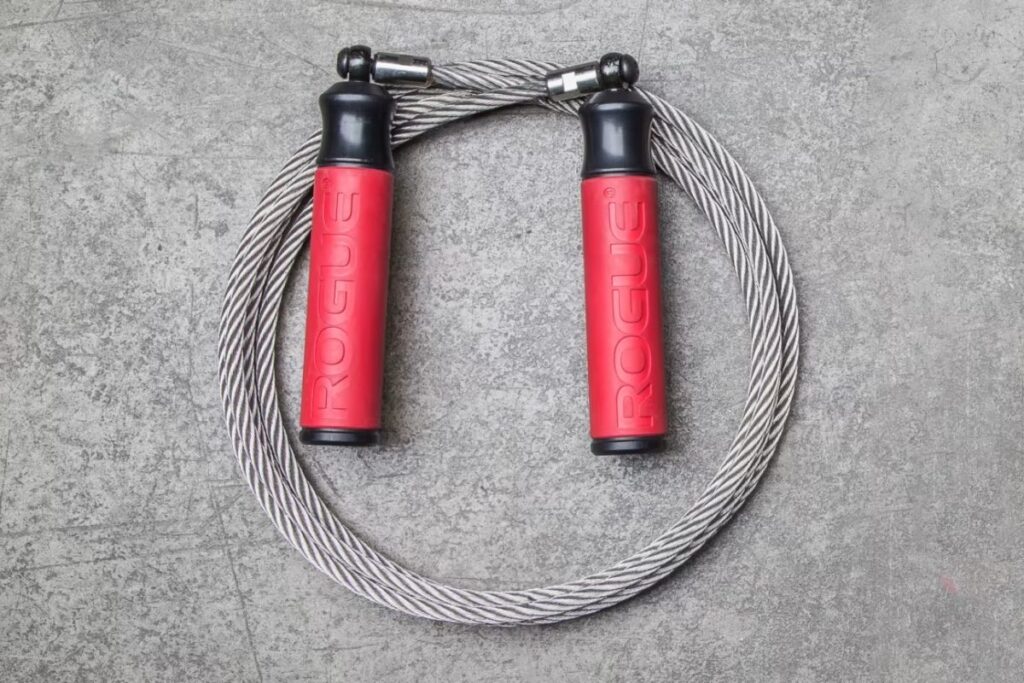
4. Ropeless Jump Ropes
Also known as cordless or cord-free ropes, they don’t have an actual rope and instead use sensors, handles with ball bearings, or LED displays to mimic the motion of jumping.
If you want to jump rope but don’t want to deal with twists, tangles, and occasional trips, then go for one of these. The downside is, there’s no need for timing, so you don’t work well on your coordination.
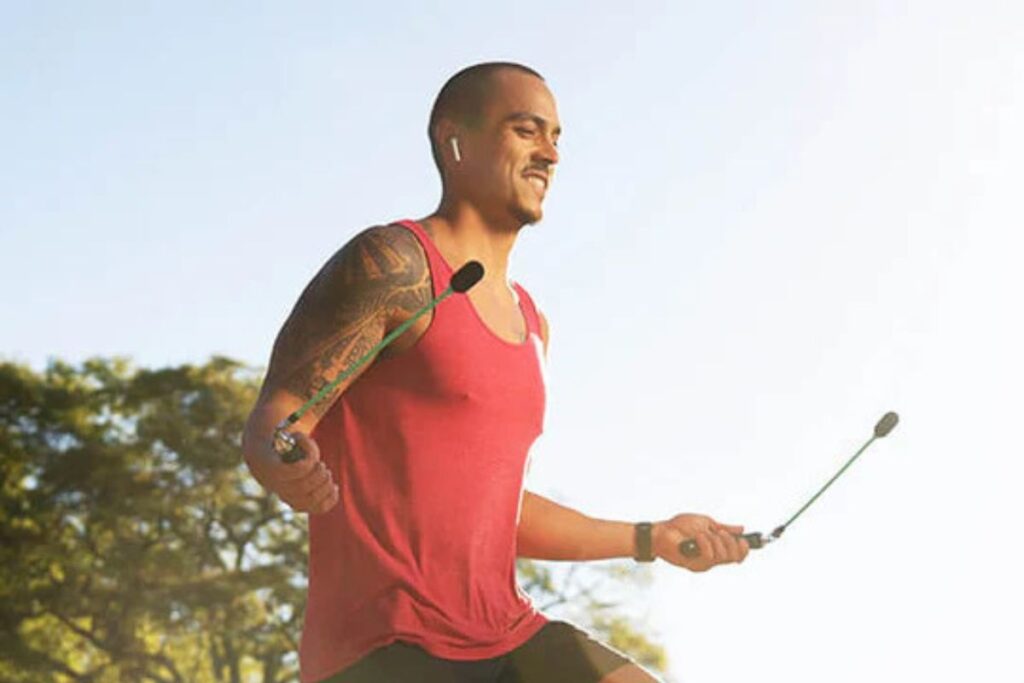
5. Beaded Jump Ropes
These look like your classic jump ropes, but they have plastic beads around the rope, and they give a tactile feel as they hit the ground, and the beads make a sound. The sound of the beads can help with timing and rhythm during workouts.
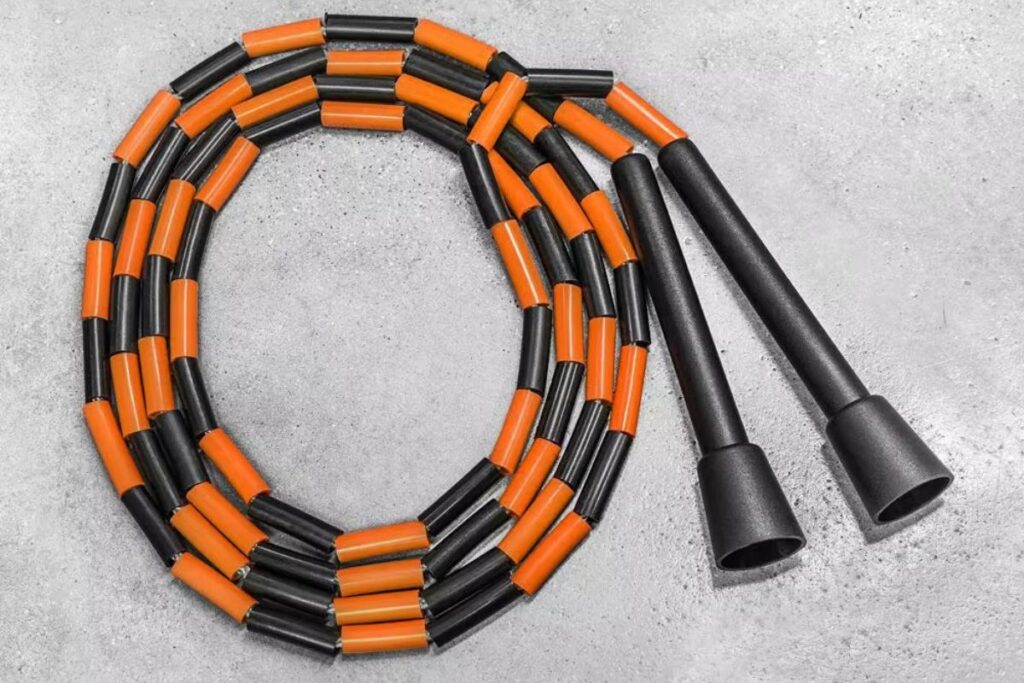
6 Benefits of Using a Jump Rope
First of all – it’s just fun, and how many exercises do you know of that are so fun even kids do them?
But besides the fun you have while you jump rope, this versatile exercise has a whole list of benefits, both physical and mental.
✅ Cardiovascular Health
Jumping rope is a fantastic way to improve your cardiovascular health and may even improve your movement capacity. It elevates your heart rate, improves blood circulation and lung capacity, and strengthens the heart muscle.
Our Ph.D. in Sports Science Sergii Putsov added:
“I incorporate jump rope into my training and my athletes’ routines in transition and recovery periods as it enhances footwork, coordination, and cardiovascular endurance.“
✅ Calorie Burning
If your priority is calorie burning, then jumping rope is a good way to do that because it can improve health markers, so if you combine it with calorie restriction, you’re golden. It can help you lose and maintain weight and it’s a very effective way to burn calories.
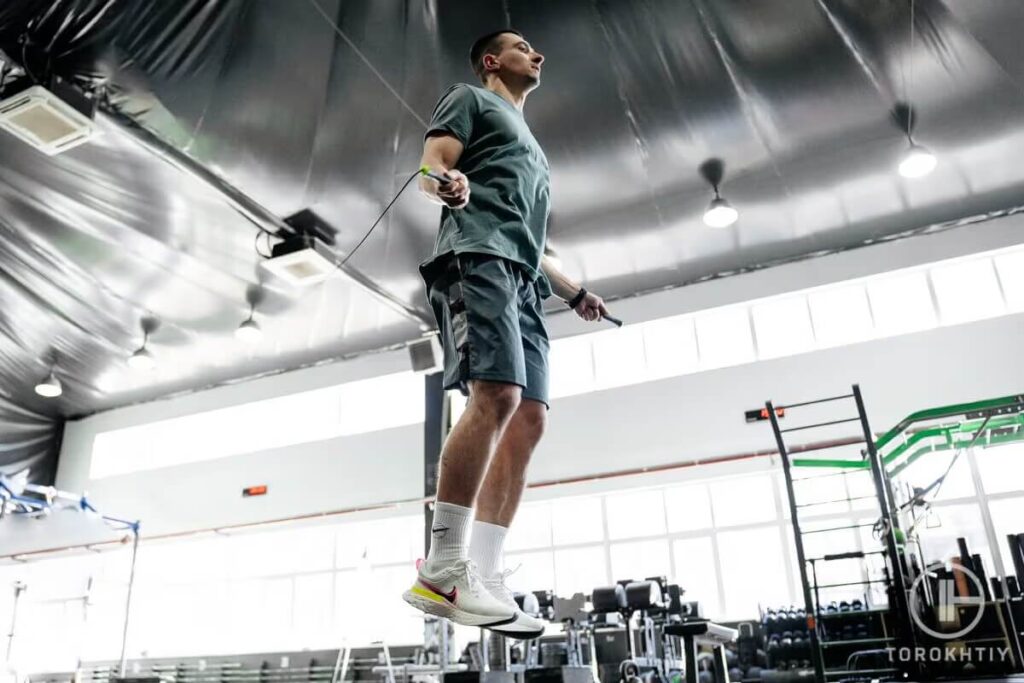
✅ Full-Body Workout
When you look at a person jumping rope, you see that their whole body is working – their legs, core, arms, shoulders… Everything is moving, so this is a great way to get a whole-body workout and tone several muscle areas at the same time.
Our expert Tanya Shaiko shares her advice:
“Jumping rope is a great way to improve aerobic endurance and coordination. The number of jumps depends on your physical fitness, but start with 5-10 minutes and gradually increase the duration. You can jump both before and after your workout; this will help to warm up your muscles and raise your heart rate. But remember that one jump rope won’t get you in shape.“
✅ Improved Coordination
Jumping rope needs your hands and feet to work together, so it’s a fantastic way to improve overall motor skills and balance. As you progress, you can even include some advanced moves and tricks, you don’t have to limit yourself to just jumping up and down.
Our performance architect and S&C movement specialist Jacek Szymanowski points out:
“I like to jump rope during warmup but also as a part of cooldown and down-regulation after workout. Crucial exercise for fight sports, working on your coordination, timing, movement efficiency, and ability to recover during movement.
I recommend it to everyone eventually. That minimum ground contact will strengthen your knees, ankles, and feet – which is important for some, I guess ;-). What jump rope is the best – one you will use with joy.“
✅ Bone Health
This is especially good for people who are at a higher risk of osteoporosis or bone-related conditions, because jumping rope can be good for bone density. Weight-bearing workouts, with some impact, like jumping rope, can be good for keeping your bones healthy and preventing osteoporosis.
✅ Stress Reduction
The motion of jumping rope and the focus that’s needed to do it can have a calming effect and can be a great way to relieve stress and anxiety.
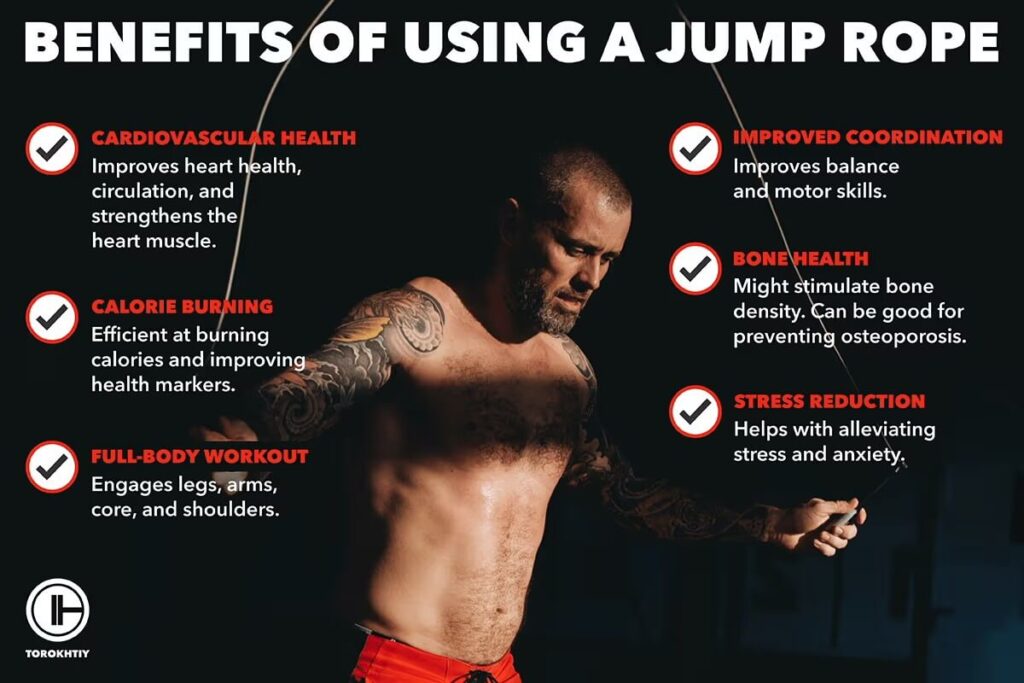
7 Things to Consider When Choosing a Jump Rope
Some jump ropes are good and can contribute a lot to your fitness routine and results, and others are a waste of time and money that will do nothing but irritate you. So, how do you know which is which?
Well, there’s no way to tell with absolute certainty which rope is going to work for you, but there are some things that are key, that every good rope has. Let’s go over the list of things to consider before buying a new jump rope.
1. Cable Features
Different cables have different benefits. For example, steel cables are known for being very durable, and those that are coated with PVC give a smoother rotation. Think about what workouts you like to do and what’s important to you when you’re deciding on what kind of material to go for.
Our orthopedic clinical specialist Ernesto Mendez noted:
“The type of jump rope is based on your needs and preferences. For instance, weightlifters will benefit from a thicker, heavier rope that provides more feedback and resistance during training. On the other hand, athletes in other sports who need to move quickly and efficiently may prefer a lighter and faster rope.“
2. Durability
If you want to jump rope on a regular basis, then you need a durable rope that won’t snap after a few uses. A lot of jump rope brands will advertise features like durability and the ability to withstand frequent use, wear, and tear, so those are your best bet.
Tips From the Champ
If you want a durable jump rope that can withstand frequent use, choose one with a steel cable coated with PVC for smoother rotation. Consider the materials used in both the handles and the cable, as high-quality materials will prolong the life of your rope and provide a better grip and performance. For comfortable handles, opt for silicone or memory foam.
Olympic Weightlifting Champion
3. Flexibility
Flexibility is going to decide what kinds of exercises you can do with your rope. A flexible cable is good for tricks and advanced moves, while a stiff rope is better for speed workouts.
4. Length Adjustability
Not everyone wants clutter that comes with owning several ropes, so if you just want to have one, then make sure its length is adjustable so you can customize it to your height.
5. Material Quality
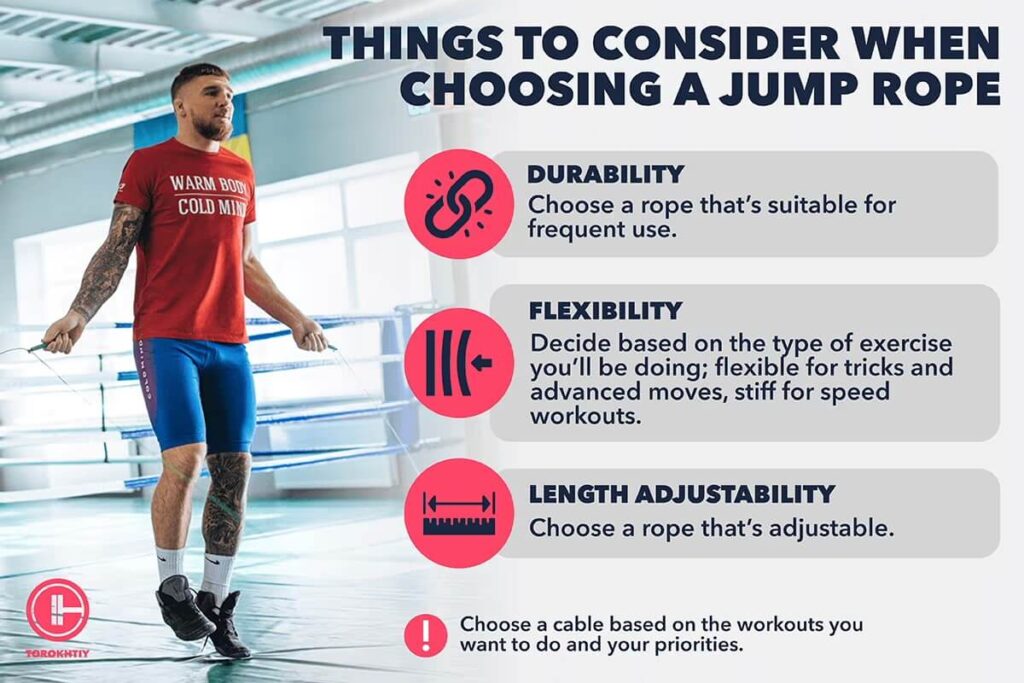
Look out for materials that are used in both handles and the cable, because high-quality materials will prolong your rope’s life, provide a better grip, and help with your performance. Handles made of silicone or memory foam are the most comfortable to hold.
Our expert, coach, and physiotherapist Zinaida Bondarenko said:
“I recommend using a classic, thin, heavy jump rope with handles. Such a jump rope is easier to rotate, simplifying the jumping technique. Athletes can focus more on the duration of their jumps.“
6. Handle Mechanism
It can vary from rope to rope, but the handle mechanism needs to align with your workout goals (speed, agility, versatility, etc.). Some handles have ball bearings or swivel systems that make the rotations smooth and reduce the risk of tangling.
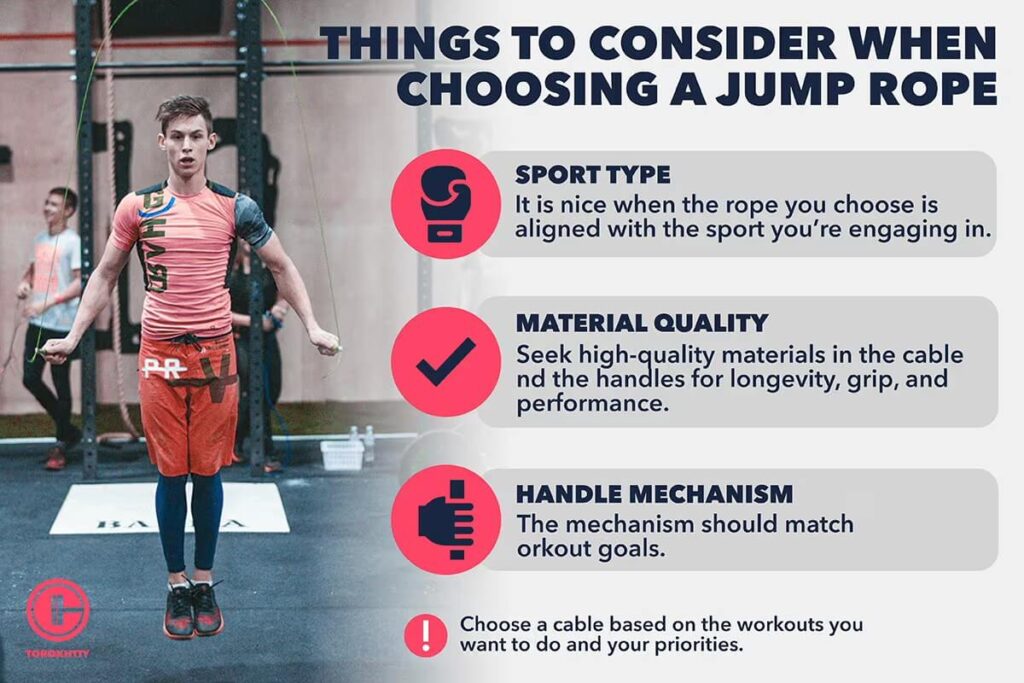
7. Sport Type Specification
Your exercise rope should go hand in hand with what you want to use it for and what your fitness goals are. Specific jump ropes are designed for certain sports or exercises; some are tailored to boxing or MMA, and some are ideal for cardio.
WBCM Adjustable Jump Rope
- Cable dimensions: 110”
- Cable material: High-speed steel cable, plastic coated
- Adjustable: Yes
- Handle dimensions: Standard ergonomic grip
- Handle mechanism: Ball-bearing rotation
- Handle material: Plastic
- Best uses for: Boxing, Cross-training, HIIT, and general fitness
- Additional features: Extra interchangeable cable, lightweight design, compact and portable
The WARM BODY COLD MIND Adjustable Jump Rope is available in multiple color combos (black, silver, pink, blue) and is built with simplicity and functionality in mind. While it may not have the premium metal handles of higher-end models, it more than makes up for it with its balanced weight, tangle-free ball-bearing rotation, and reliable grip.
The stem is reinforced, which is great, because that makes the rope more durable, so you can use it for super intense sessions without worrying you will damage it. The rope has knurled aluminum handles that are grippy enough even if your hands are sweaty and the patented dual axis rotation.
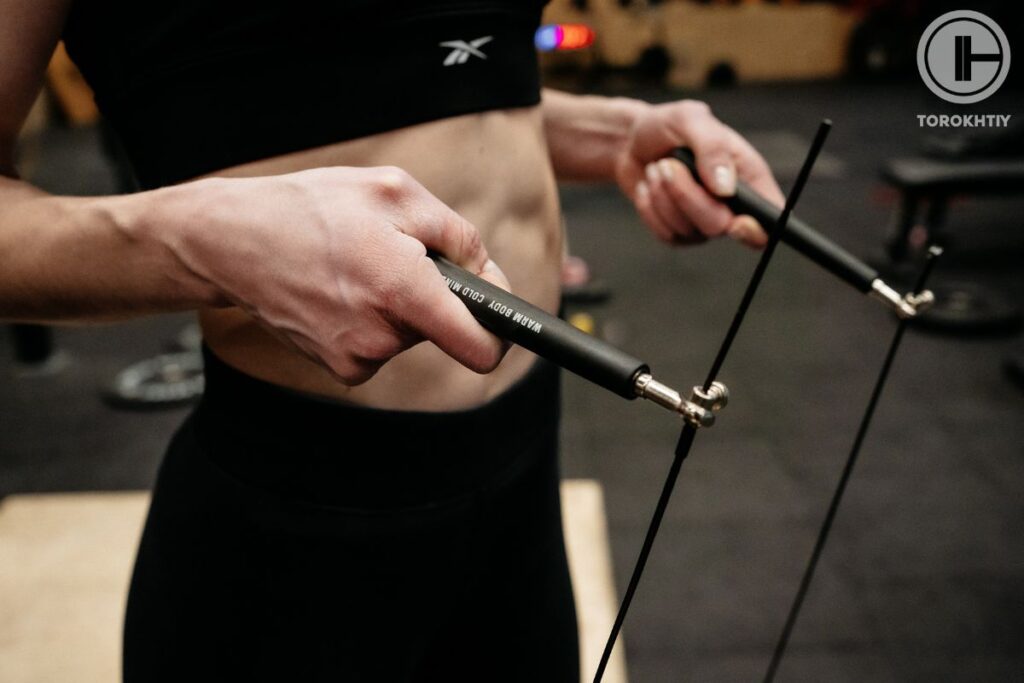
The lightweight construction makes it ideal for travel or gym use, and the ergonomic handles—though plastic – offer a surprisingly secure grip even during high-rep sets. The included spare cable is a thoughtful touch, letting you quickly swap out if needed or simply keep a backup on hand.
The cable measures 110”, which is adjustable with a cable cutter and screwdriver, giving you full control over fit and comfort. While it lacks some of the technical flair of elite ropes, this one nails the fundamentals – and for the price, it’s hard to beat. A solid choice for everyday use, especially for those just getting into jump rope training or looking for a no-fuss backup rope.
Jump Rope Workout You Can Add to Your Training Routine
It’s not unusual to see people skip great workouts because they don’t quite know how to include them in an already existing routine. If you’re one of them, then you’ve stumbled upon exactly what you need – an explanation of how to include a jump rope into a workout routine.
Also, don’t forget to warm up. Before your workout and cool down after – you can use your jumping rope for both, it doesn’t need to be limited to the workout only. If you’re warming up for something more intense, jumping rope can be a good addition to an already established warm-up routine.
1. Beginner
Set 10-15 minutes aside for this workout. You’ll start by just jumping at a moderate pace and focus on perfecting your form. Keep your feet together, land softly, and keep your rhythm steady. Try to jump without stopping for 2 to 3 minutes.
Then, move into a basic skip, where you alternate jumping on each foot. Do this for 2 to 3 minutes, and then finish with a few minutes of jumping non-stop while slowly increasing your speed. Remember to breathe and maintain good posture.
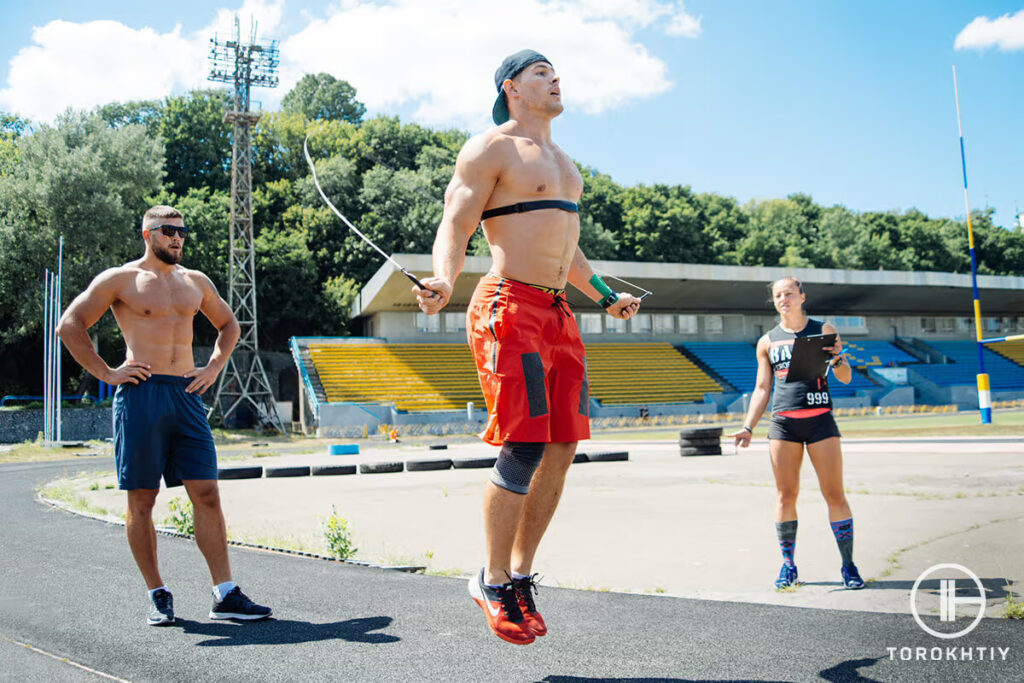
2. Intermediate
Your workout will last for 20 to 30 minutes, and you’ll start with 5 minutes of mixing basic jumps with high knees. Then, do 1 minute of high-intensity jump rope intervals and do as many jumps as possible. Follow this with 1 minute of basic skips and side swings.
Repeat this for 10-20 minutes and finish with 5 minutes of crossovers and double-unders.
Our expert Ernesto Mendez had this tip to share:
“To achieve general fitness, jumping rope for 15-30 minutes three to five times per week is recommended.“
3. Advanced
You’ll need about 40 to 45 minutes to complete your workout that starts with 10 minutes of dynamic stretches and warm-up. After that, do a 3-minute high-intensity circuit that is a mix of 30s double-unders and 30s high knee jumps alternating, and try to keep your pace consistent.
Rest for 1 minute and then repeat the same circuit 5 times, resting for 1 minute between each of them. Try to rest while jumping with an easy tempo.
Finish with 10 minutes of jump moves of your choice, like a single leg at a moderate pace, and then cool down.
| Level | Duration | Workout |
|---|---|---|
| Beginner | 10-15 minutes | Jump at a moderate pace for 2-3 minutes, then do a basic skip for 2-3 minutes, and finish with a few minutes of non-stop jumping at increasing speed |
| Intermediate | 20-30 minutes | Mix basic jumps with high knees for 5 minutes and then do 1 minute of high-intensity jump rope intervals followed by 1 minute of basic skips and side swings. Repeat this for 10-20 minutes |
| Advanced | 40-45 minutes | Start with 10 minutes of dynamic stretches. Then, do 3 minutes of high-intensity circuit of double-unders, and high knee jumps. Repeat this 5 times with 1-minute rest periods in between. Finish with 10 minutes of moderately paced jump rope moves like crossovers and single legs and a 5-minute cooldown |
Our expert Zinaida Bondarenko had this to say:
“To lose weight with a jump rope, it’s important to follow a consistent routine, gradually increasing the jumping time. Aim to jump rope for at least 30 minutes a day, five days a week.“
4 Jump Rope Alternatives
Although jumping rope is a fantastic cardio with a ton of benefits, it’s not suitable for everyone and for every situation. And even if you’re a die-hard fan of jumping rope, you may want to switch things up sometimes to keep your workouts interesting.
1. Jumping Jack
Jumping jacks are a great alternative to jumping rope. It involves jumping to a position with the legs spread wide and the hands touching overhead, then returning to a position with the feet together and the arms at the sides.
It’s an effective full-body exercise that improves cardiovascular fitness and agility without needing any equipment.
2. High-Knee Running in Place
This exercise involves jogging on the spot while lifting your knees as high as possible, engaging the core, leg muscles, and improving coordination. It’s a full-body exercise that boosts heart rate and targets multiple muscle groups, including the lower abs, hip flexors, and quads.
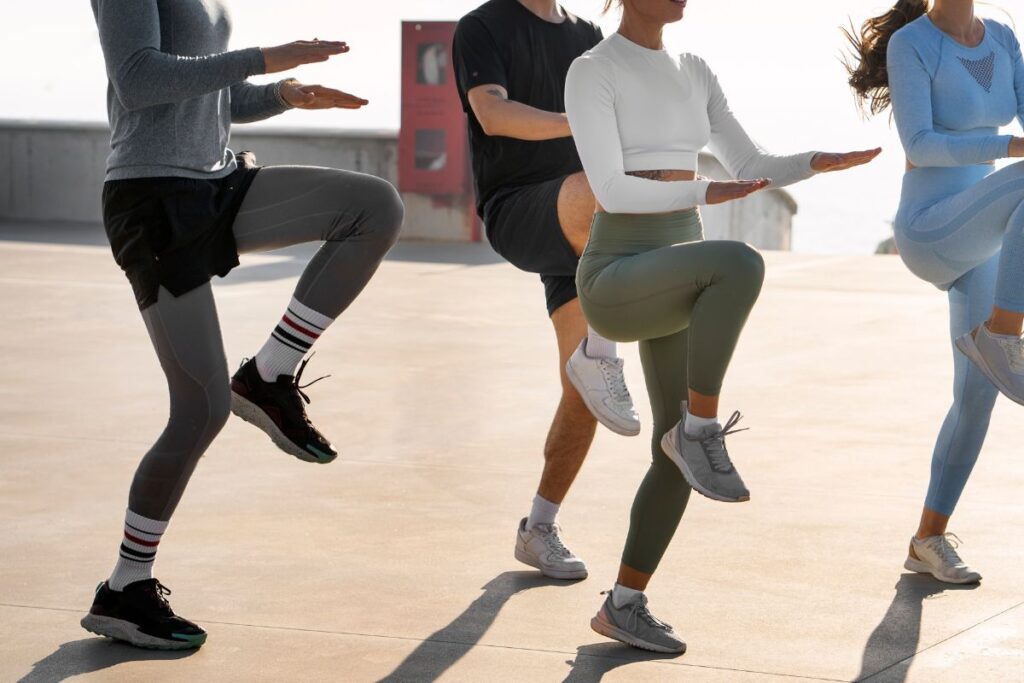
3. Aerobics
You could also try aerobics or dance workouts, they’re both a fun alternative that are going to give your entire body a good workout.
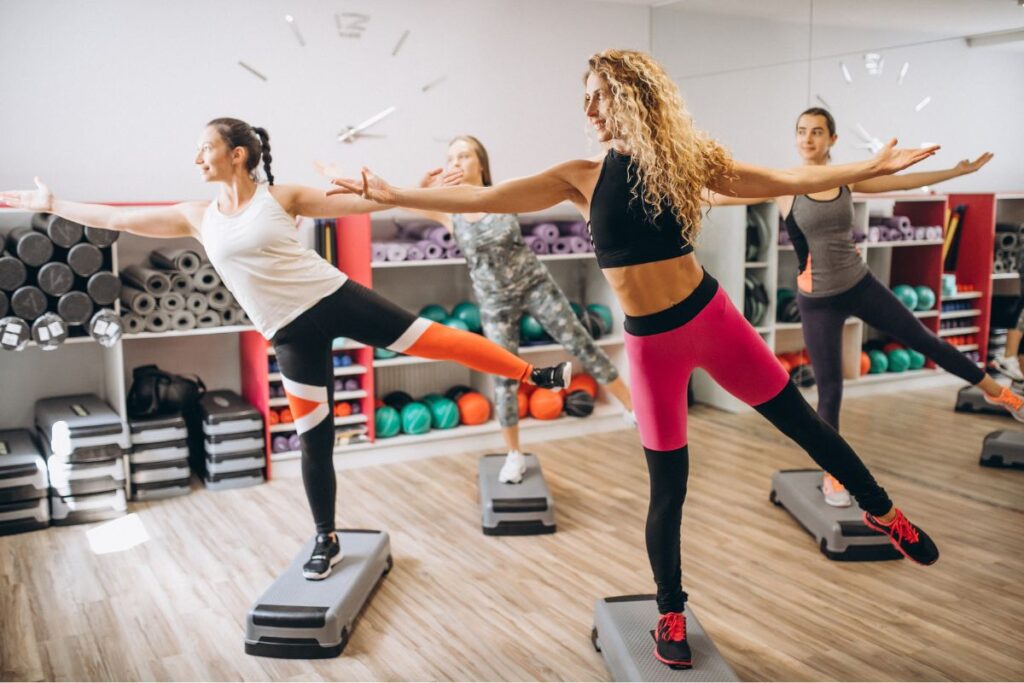
4. Resistance Training
Let’s not forget good old resistance training or bodyweight workouts combined with cardio intervals: it’s a well-rounded and very effective routine great for general physical preparedness (GPP).
FAQ
How Many Calories Does 30 Minutes of Jump Rope Burn?
It depends on your weight and jumping intensity, but generally, 30 minutes of jumping rope can burn about 300 to 450 calories.
Is Jump Rope Better Than Running?
Both are excellent cardio, and one is not better than the other. The choice depends on what you like better and what your fitness goals are.
Jumping rope is more time-efficient and can be done indoors, while running is better for endurance training and people who want to work out outside. Think about what you can get from exercise and how it will/can affect your life/training.
Is It Ok to Jump Rope Every Day?
Rest days are very important, so even if you love jump roping and can never get enough of it, you should have at least one day a week where you rest and don’t work out at all.
Being a couch potato has its perks, so pretend you are one and give yourself a break sometimes. If you really want to jump rope every day, you can do so as part of active recovery, but the intensity needs to be low.
Conclusion
Jumping rope is one of the easiest and most affordable ways to stay active and have fun at the same time. It has a lot of health benefits and people of all ages and fitness levels can do it. The perfect companion to your workout session is, of course, the WBCM Adjustable Jump Rope. Its performance and quality are unmatched, and you get a fantastic value for money with it.
Do you like jumping rope or do you prefer some of its alternatives? Do you have a fitness jump rope to recommend? Have you tried the jump rope we recommend? What do you think are the most important features a good jump rope has?
Leave your opinions and suggestions in the comment section!
Jumping out!
Experts Who Contributed To This Article
Olympian with 21 years of Oly Lifting experience
6 years of Oly Lifting & Training experience
20 years of Oly Lifting & Training experience

Coach, Physiotherapist
Orthopedic Clinical Specialist (OCS)
M.Sc.Eng. Biotechnology, Sports Nutritionist

Also read:
- How Long Should A Jump Rope Be
- Best Functional Fitness Jump Rope (Best Jump Rope For Double Unders)
- Best Jump Rope For Boxing
- How To Do Double Unders
- How To Get Better At Jump Rope
- Jump Rope Vs Speed Rope
References:
- Athos Trecroci, Luca Cavaggioni, Riccardo Caccia, Giampietro Alberti, “Jump Rope Training: Balance and Motor Coordination in Preadolescent Soccer Players,” Journal of Sports Science and Medicine 14, no. 4 (2015): 792-798, https://www.ncbi.nlm.nih.gov/ pmc/articles/PMC4657422/ (accessed November 7, 2023).
- Felipe García-Pinillos, Carlos Lago-Fuentes, Pedro A Latorre-Román, Antonio Pantoja-Vallejo, Rodrigo Ramirez-Campillo, “Jump-Rope Training: Improved 3-km Time-Trial Performance in Endurance Runners via Enhanced Lower-Limb Reactivity and Foot-Arch Stiffness”, Int J Sports Physiol Perform. 2020 Mar 12;15(7):927-933, https://pubmed.ncbi.nlm.nih.gov /32163923/ (accessed November 15th, 2023).
- Hyoung-Kil Park, Min-Kyung Jung, Eunkyung Park, Chang-Young Lee, Yong-Seok Jee, Denny Eun, Jun-Youl Cha, Jaehyun Yoo, “The Effect of Warm-Ups with Stretching on the Isokinetic Moments of Collegiate Men,” Journal of Exercise Rehabilitation 14, no. 1 (2018): 78-82, https://www.ncbi.nlm.nih.gov/pmc /articles/PMC5833972/ (accessed November 7, 2023).
- Kathryn Watson, “The Benefits of Jumping Rope Go Beyond Weight Loss,” Healthline, https://www.healthline.com/ health/jumping-rope-to-lose-weight (accessed November 7, 2023).
- KyoChul Seo, “The Effects of Dance Music Jump Rope Exercise on Pulmonary Function and Body Mass Index after Music Jump Rope Exercise in Overweight Adults in 20’s,” The Journal of Physical Therapy Science 29, no. 8 (2017): 1348-1351, https://www.ncbi.nlm.nih.gov/pmc /articles/PMC5574342/ (accessed November 7, 2023).
- Veena Kirthika, Sudhakar S., Senthil Selvam, “The Effect of Skipping rope Exercise on Physical and Cardiovascular fitness among Collegiate Males”, Research Journal of Pharmacy and Technology 12, no. 10 (2019): 4831-4835, https://www.researchgate.net/ publication/337469492_ The_Effect_of_Skipping_rope_ Exercise_on_Physical_and_ Cardiovascular_fitness_ among_Collegiate_Males (accessed November 7, 2023).
- Zhaoxie Tang, Yingan Ming, Miao Wu, Jiajia Jing, Suhua Xu, Hailin Li, and Yanna Zhu, “Effects of Caloric Restriction and Rope-Skipping Exercise on Cardiometabolic Health: A Pilot Randomized Controlled Trial in Young Adults”, Nutrients 13, no. 9, (2021): 3222, https://www.ncbi.nlm.nih.gov/pmc /articles/PMC8467906/ (accessed November 7, 2023).
- Photos are made by Torokhtiy Media Team, Freepik.com, Roguefitness.com, Crossrope.com
Why Trust Us?
With over 20 years in Olympic weightlifting, strength training, nutrition coaching, and general fitness our team does its best to provide the audience with ultimate support and meet the needs and requirements of advanced athletes and professional lifters, as well as people who strive to open new opportunities and develop their physical capabilities with us.
By trusting the recommendations of our certified experts in coaching, nutrition, and sports training programming, as well as scientific consultants, and physiotherapists, we provide you with thorough, well-considered, and scientifically proven content. All the information given in the articles concerning workout programming, separate exercises, and athletic performance, in general, is based on verified data.
The product testing process is described in more detail here.
Author: Ihor Shymechko
Pro Olympic Weightlifter, Coach
Best Results: Snatch – 208 kg,
C&J – 240 kg
Ihor has been a professional weightlifter since 1996, boasting over two decades of competition experience. His notable achievements include clinching the European Championship in 2009 and securing a silver medal in the 105kg division at the Senior World Championships in 2011. Ihor represented his country in the 2008, 2012, and 2016 Summer Olympics. After retiring from competitive weightlifting, he transitioned to coaching, leveraging his vast experience to guide athletes who now compete on both national and international stages.
Reviewed by: Oleksiy Torokhtiy
Olympic Weightlifting Champion, PhD in Sport Science
Best Results: Snatch – 200 kg,
C&J – 240 kg
Oleksiy Torokhtiy is a professional athlete boasting 20 years of experience in Olympic weightlifting. With multiple European and World titles under his belt, he has showcased his prowess in two Olympic Games (Beijing 2008 and London 2012). Upon concluding his illustrious career, Oleksiy dedicated himself to coaching. By 2022, he had conducted over 200 weightlifting seminars worldwide. He is the visionary behind an international sportswear and accessories brand known for its motto, “Warm Body Cold Mind.” Additionally, he is an esteemed author and the creator of a series of training programs and eBooks.





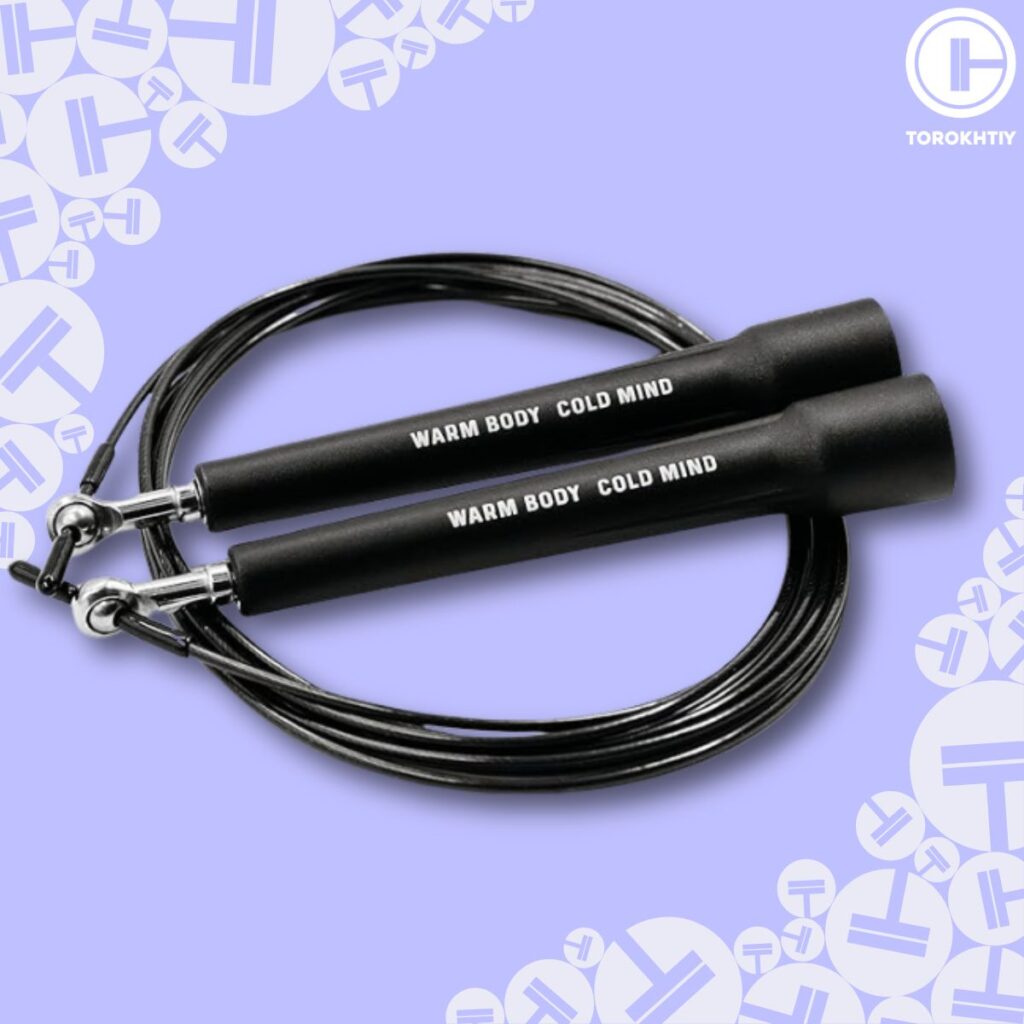




Still have questions after reading our article? Unlock your full potential by engaging with our experts and community! Don’t hesitate — leave a comment below and Ihor Shymechko will provide a personalized answer and insights to help you reach your goals.